- Sustainability
- DE&I
- Pandemic
- Finance
- Legal
- Technology
- Regulatory
- Global
- Pricing
- Strategy
- R&D/Clinical Trials
- Opinion
- Executive Roundtable
- Sales & Marketing
- Executive Profiles
- Leadership
- Market Access
- Patient Engagement
- Supply Chain
- Industry Trends
Product Launch: Five Paths Forward
Pharm Exec’s annual feature profiling a selection of notable biopharma brands focuses this year on new beginnings and new promise-spotlighting five products with compelling product launch stories that tie strongly with the industry’s broader and evolving market-entry landscape.
Pharm Exec’s annual feature profiling a selection of notable biopharma brands is switching gears in 2019. Instead of recognizing the “Brands of the Year,” the theme is new beginnings and new promise, spotlighting five products with compelling product launch stories. Whether commercial firsts or important franchise expansions, these treatments all share unique paths to market entry-and tie strongly to the industry’s broader product launch landscape.
Prevent Defense
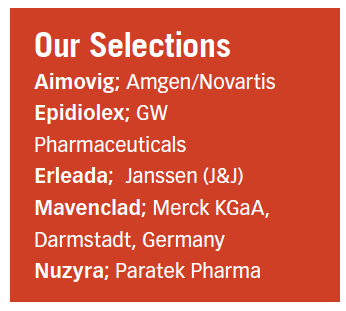
Aimovig
Unleashing Novel Migraine Market
In May 2018, FDA approved Aimovig (erenumab-aooe), a Novartis and Amgen collaboration for migraine prevention. Rather than treating symptoms once they appear, the subcutaneous injection targets the calcitonin gene-related peptide (CGRP) receptor that is believed to play a role in the inflammatory processes that bring on migraines.
Aimovig was the first drug to be approved in the new class of CGRP monoclonal antibodies. Since then, the market has grown considerably, with the approvals of Lilly’s Emgality and Teva’s Ajovy. Earlier this year, FDA accepted new drug applications for Alder BioPharmaceuticals’ eptinezumab and Allergan’s ubrogepant. The latter could become the first oral CGRP to hit the market. The drugs in this class have been specifically developed to prevent migraines, in contrast to the antiseizure, antidepressant, and blood-pressure-lowering medications that have been traditionally used for prevention.
Aimovig is self-administered once monthly using the SureClick autoinjector. The recommended dose is typically 70 mg but is also available in 140 mg; it’s injected into the upper arm, thigh, or abdomen. Since its
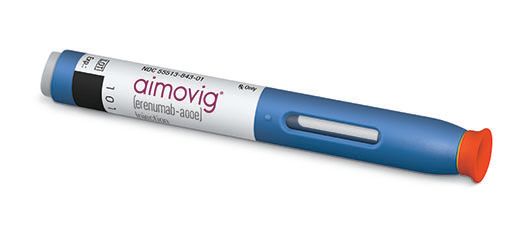
launch, approximately 225,000 patients have been prescribed Aimovig.
Migraine is the sixth-most disabling illness worldwide, according to the Migraine Research Foundation. It affects 39 million men, women, and children in the US (one billion globally) and can be incapacitating. The costs of treating this population have been estimated at $22 billion annually.
The International Headache Society diagnoses migraine based on the pain and frequency of attacks, at least five a month, that last anywhere from four to 72 hours. Symptoms can range from nausea, vomiting, sensitivity to light and/or sound; and can be elicited by stress, anxiety, hormonal changes, bright or flashing lights, lack of food or sleep, and dietary substances. A recent report by the Pharmacy Benefit Management Institute (PBMI) found that direct healthcare costs for patients with migraine were estimated at $2,571 higher than those for similar patients who don’t experience migraine.
In clinical studies, Aimovig proved to decrease the number of migraine days, with a 50% reduction for some patients. “On top of cutting the number of migraine days, patients were able to reduce the use of migraine-specific medication,” Emilie Grand-Perret, VP and head of Aimovig marketing, Novartis, told Pharm Exec, adding that the drug was studied in a variety of patient populations for episodic and chronic migraine. Amgen and Novartis do look at the number of migraines a patient has each month, but the companies say the most critical measure for Aimovig is impact on quality of life and how debilitating migraine days are.
In July, Novartis announced that additional data from a Phase III study confirmed that Aimovig 140 mg decreases the number of monthly migraine days (MMD) as well as migraine-specific medication days (MSMD), supporting the long-term efficacy of Aimovig for patients who have struggled to find effective preventive therapies specifically designed for migraine.
Pricing and access
Cost and competing for formulary coverage have been cited as potential obstacles for CGRPs. The list price for Aimovig is $6,900 per year, or $575 a month. The manufacturers have established reimbursement solutions to increase patient access and lower cost burdens, however. “We felt we had an incredible responsibility to make sure that Aimovig would be available to all patients,” says Carly Baron, executive director, head of Aimovig marketing, Amgen.
To ensure quick access, Amgen and Novartis created a bridge program where patients can receive up to 12 free doses while they wait for insurers to process and approve their claims. More than 80% of claims are approved and patients typically pay only a $5 copay, according to the companies. For those unable to secure coverage, there are patient assistance programs available if income requirements are met.
Outreach and education
The real hurdle that Aimovig faces is a lack of understanding and acceptance of the disabling impact migraine has on patients’ lives. The disease is regularly stigmatized, with a common opinion that people with migraine are faking it or exaggerating the pain. Family, friends, and even physicians often have misperceptions of migraine, and patients are “up against a tough climb in terms of trying to make sure they’re understood,” says Baron.
To combat this challenge, Amgen and Novartis launched the “I Am Here” campaign to educate the public on migraine and Aimovig. The campaign consists of TV and online commercials, along with substantial engagement with patients on social media. Commercials depict not just the big moments in patients’ lives, such as weddings, graduations, and anniversaries, but moments like going to work, changing a baby’s diaper, or arguing with a significant other.
The campaign’s aim is to show migraine sufferers that Aimovig can help them be more present in their daily lives by potentially delivering better health outcomes. The strategy to use direct-to-patient and social media marketing to reach and motivate “unheard” patients has proven successful so far, the companies say.
- Christen Harm
Pharm Exec's remaining product launch stories are chronicled ahead, by alphabetical order ...
Medical Milestone
Epidiolex
Planting Seed for Future Promise
As people have become increasingly aware of the medicinal benefits of marijuana, it was only a matter of time before a prescription cannabidiol (CBD) was approved by FDA. In June 2018, the agency made history by approving GW Pharmaceuticals’ Epidiolex. The twice-daily dose was indicated for seizures caused by two of the most rare, severe, and treatment-resistant forms of childhood-onset epilepsy-Dravet syndrome and Lennox-Gastaut syndrome (LGS)-in patients two years of age and older. It is the first medication to be approved specifically to treat Dravet syndrome, the first drug in a new category of anti-epileptic therapies, and the US’s first FDA-approved prescription formulation of highly purified CBD.
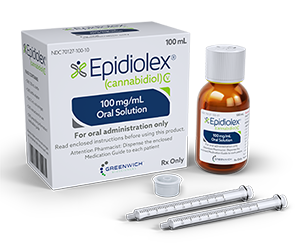
“Throughout the entire process, GW was breaking new ground,” says Steve Schultz, the company’s vice president of investor relations. “This was a completely novel experience, from running clinical trials in very challenging patient populations with essentially a brand-new medicine and mechanisms of action to [being] approved and commercializing the drug.”
Epidiolex originally received fast-track designation for Dravet syndrome and orphan-drug designation for both Dravet syndrome and LGS in the US. The drug’s FDA priority review led to it being approved last June.
A major obstacle for Epidiolex was that all cannabis products were still considered Schedule I at the time. It took strong safety data to get the Drug Enforcement Agency (DEA) to move Epidiolex into its least-restrictive class in September 2018. That paved the way for the drug’s launch two months later.
The next step for Epidiolex is gaining approval from the European Medicines Agency (EMA), which is anticipated around October. After that, GW plans to launch Epidiolex in the EU, starting with France and Germany, followed by the UK, Italy, and Spain.
In addition, GW plans to file a supplemental drug application with FDA later this year for the treatment of seizures associated with tuberous sclerosis complex (TSC) and also is recruiting for Phase III trials to study Epidiolex’s impact on seizures and other symptoms associated with Rett syndrome, a rare non-inherited genetic postnatal neurological disorder that occurs primarily in girls.
“Rett syndrome is an interesting indication for us, because it’s the start of us moving outside of seizures as a primary focal point,” says Schultz. “Our goal with Rett is to not only show that it is effective in reducing seizures in Rett patients, but also to be able to measure and put forward evidence as to the effectiveness of Epidiolex in more cognition and behavioral measurements.”
Access and marketing
To promote patient access, GW set the price of Epidiolex to be in line with other brand-name epilepsy drugs. The average US list price for the drug is $32,500 per year, however, costs are widely covered by insurance. GW’s Epidiolex Engage program also offers copay savings and patient assistance programs.
Since launch, more than 2,500 physicians have prescribed Epidiolex, and more than 12,000 patients have received prescriptions. Though an overwhelming initial demand caused some patients to wait four weeks for their first prescription fills, GW has reduced wait time to two weeks.
A good deal of confusion exists around the various forms of cannabis. To clarify matters and help Epidiolex stand out, GW has concentrated on educating physicians about the drug’s safety and efficacy. In order to cut through the CBD hype and focus on the quality of Epidiolex, the company has a sales force of 60 neurology account managers targeting about 5,000 physicians. It also has placed ads in respected neurology journals and even launched an unbranded website, Cannabinoid Clinical (cannabinoidclinical.com), full of information, resources, and tools. Because of the small patient population, GW chose digital and social marketing to reach patients and caregivers. The biopharma also has partnered with advocacy groups.
“The focus of our company is to provide a much-missing, and we believe much-needed, facet to the whole CBD discussion, which is scientific evidence that proves that CBD can be effective in some very specific therapeutic targets,” says Schultz. “I think we’re the only company right now that’s been able to provide that type of Âevidence, and we believe it’s the type of evidence and reassurance that both patients and physicians desire.”
Growing business
The immediate success of Epidiolex has been promising for the future of cannabis-based drugs. The drug posted $33.5 million in Q1 net sales-more than double the market expectations of $16 million. Q2 net sales of Epidiolex more than doubled, coming in at $68.4 million, exceeding the average analyst outlook of about $47 million. Informa Intelligence analysts predict peak annual revenue of $822 million in 2025. With potential EU approval and additional indications, some analysts think Epidiolex could achieve blockbuster status.
Future of CBD medicine
GW is testing a number of additional cannabinoids in its pipeline. It will seek US approval for Sativex, which is currently approved outside the US for the treatment of multiple sclerosis spasticity. Also on the horizon are products in Phase I and II trials for autism spectrum disorders, glioblastoma, and schizophrenia.
“There’s a lot of anecdotal talk about where cannabinoids, and, specifically, CBD, could apply from a medical standpoint. But until you have the science behind it, you don’t have really any evidence,” says Schultz. “Physicians and patients need confidence in the medicine they’re prescribing and taking, and the only way to have that level of confidence is to have a medicine that has been through the FDA process.”
- Elaine Quilici
Brand Buildout
Erleada
New Chapter in Survival Story
While prostate cancer remains the second leading cause of cancer death in American men, just behind lung cancer, the American Cancer Society (ACS) observes that “most men diagnosed with prostate cancer do not die from it.” In fact, the ACS goes on, “more than 2.9 million men in the United States who have been diagnosed with prostate cancer at some point are still alive today.”
Zytiga (abiraterone acetate) from Janssen (part of Johnson & Johnson) has played a part in the declining number of prostate cancer deaths since its first approval for metastatic castration-resistant prostate cancer (mCRPC) in 2011. (Around 10–20% of prostate cancer cases are castration-resistant; mCRPC is prostate cancer that keeps growing even when the amount of testosterone in the body is reduced to low levels.) As noted by Evaluate Ltd.’s Vantage (Jan. 31, 2019), Zytiga plus androgen deprivation therapy (ADT) “set the bar” in the LATITUDE and STAMPEDE trials in men with high-risk mCRPC. LATITUDE showed that Zytiga plus ADT reduced the risk of death by 38% and radiographic progression by 53%; STAMPEDE showed a 37% benefit
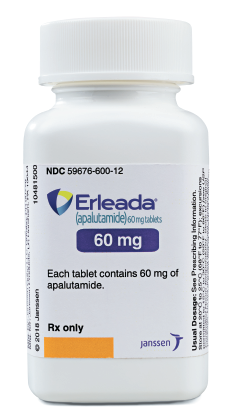
with Zytiga on overall survival. By November 2018, the drug had reached nearly $1 billion in quarterly sales, half of which came from the US. At the same time, the doors to generic competition were flung open when the US appeals court turned down J&J’s appeal to block generic sales of Zytiga.
Looking to extend its prostate cancer franchise, Janssen has since pushed Erleada (apalutamide)-an androgen receptor inhibitor indicated for the treatment of patients with non-metastatic castration-resistant prostate cancer (nmCRPC)-further into the spotlight. Erleada was the first drug to be cleared (in February 2018) on the strength of metastasis-free survival (MFS). The SPARTAN study, involving over 1,200 patients with nmCRPC, showed the median MFS for patients taking Erleada was 40.5 months, compared to 16.2 months for placebo. Endpoints News (March 22, 2018) observed that the FDA approval, “months ahead of the normal regulatory schedule,” underscored the agency’s “willingness to run out the green light in record time, particularly in oncology.”
“Until the 2018 launch of Erleada in the US, patients had no other approved treatments to help delay the spread of prostate cancer to other parts of the body,” Reshema Kemps-Polanco, vice president, solid tumor franchise, Janssen Biotech, told Pharm Exec. Since February 2018, thousands of patients have been treated with Erleada, and Janssen is “very pleased with the response to the drug from patients, healthcare providers (HCPs) in both urology and oncology, and from the scientific community,” says Kemps-Polanco, adding that the drug “has broad payer coverage for patients with nmCRPC and we see new writers each quarter.”
She goes on: “While we continue to educate HCPs and patients on the benefits of Erleada in the nmCRPC population, we are also building the future of [the brand] with our comprehensive clinical development program. We continue to study Erleada plus ADT and in combination treatment approaches with the goal to intervene earlier to prolong survival and delay disease progression.”
Indeed, this year’s TITAN trial boosted the brand’s profile further. The trial-which compared Erleada plus ADT versus ADT alone in patients with newly diagnosed metastatic castration-sensitive prostate cancer, to show benefit on overall survival and radiographic progression-free survival (rPFS)-was stopped early for “positive efficacy.” The results, presented in an oral session at the American Society of Clinical Oncology (ASCO) Annual Meeting in Chicago in May, revealed that Erleada plus ADT “significantly extended overall survival compared to placebo plus ADT, with a 33% reduction in the risk of death.” Erleada plus ADT also “significantly improved rPFS compared to placebo plus ADT, with a 52% reduction in risk of radiographic progression or death compared to placebo plus ADT.”
As Vantage reported, these results have given Janssen a chance to move Erleada “into a new and more relevant use.” The data presented at ASCO also formed the basis of a supplemental new drug application, currently under review by FDA, seeking approval of a new indication for Erleada for the treatment of patients with metastatic castration-sensitive prostate cancer.
Kemps-Polanco told Pharm Exec that she is “inspired by the bright future ahead” for the drug. (Some analysts are predicting sales of Erleada to reach $2 billion by 2022.) While the number of prostate cancer diagnoses and annual deaths has steadily declined over the past 25 years, there is still “more work to be done,” she stresses. Janssen, Kemps-Polanco adds, is striving to “evolve the research and to help patients living with prostate cancer by providing more treatment options across the disease continuum.”
- Julian Upton
Adherence Mission
Mavenclad
Dose, Delivery Gains for MS
In March 2019, Mavenclad, from Merck KGaA, Darsmtadt, Germany (EMD Serono in the US and Canada), became the first FDA-approved treatment for relapsing-remitting multiple sclerosis (RRMS) and active secondary progressive MS (SPMS) to provide two years of proven efficacy with a maximum of 20 days of oral treatment over a two-year period.
Clinical studies showed that Mavenclad (cladribine) reduced patients’ relapse rate by between 55% and 58%, and that patients taking the drug were 33% less likely to have disease progression than those taking placebo. But it is Mavenclad’s short and convenient treatment course, requiring no injections or infusions, that heralds it as “a new way to treat MS.” Just 10 days of oral tablet therapy are required at the start of the first year of treatment and another 10 days at the beginning of year two, with no treatment in years three and four.
As Chris Round, head of international operations and global core franchises at Merck KGaA, Darsmtadt, Germany, told Pharm Exec, the impact of this “relatively small and contained profile is quite extraordinary, and essentially gives patients the opportunity to feel like they’re living a life without the disease, without a daily
Chris Round

reminder that they have a medical condition.”
Mavenclad’s FDA approval in March-for the treatment of adults with RRMS and active SPMS-came some 19 months after its European Union approval in August 2017. (It is now approved in over 50 countries.) The drug’s approval journey goes back much further, however. Cladribine was originally approved by FDA in 1993 as an orphan drug to treat hairy cell leukemia. In the mid-1990s, Scripps Laboratories began trials of cladribine for MS. By 2007, a series of rights and business acquisitions saw the drug reach the hands of Merck KGaA, Darmstadt, Germany. But the company’s first submissions of cladribine as a treatment for MS were rejected by the European Medicines Agency (EMA) and FDA in 2010 and 2011, citing a perceived cancer risk and an unclear benefit-to-harm ratio, respectively. With several MS clinical trials still ongoing, Merck KGaA Darsmtadt, Germany eventually decided to push forward with the drug with renewed determination. In 2015, the company announced it would again seek approval with data from the completed clinical trials.
European breakthrough
For Round, the greatest challenge around launching Mavenclad was to “advance historic perceptions of the product related to the previous filing in the EU and US, and also the large amount of time that elapsed from the end of our Phase III trials and when we re-filed in Europe.” Round and his team maximized their chance of success by “enabling physician and patient access as quickly as possible with a compelling payer value proposition, including novel contracting agreements; initiating a comprehensive Phase IV program to supplement existing data; increasing our field-based medical teams to ensure HCPs questions were answered quickly; and enabling peer-to-peer exchange of early experience with Mavenclad.”
Round says he is particularly proud of the way his team handled the experience. “Our company has been really strong at maintaining successful, mature brands in a competitive environment. However, Mavenclad was our first global launch in a long time, so the team had to adapt and learn,” he says. “We built the right team by putting our best internal talent on the launch and augmenting this with external talent with relevant launch experience. We came at it with the right mindset, with the team recognition that Mavenclad could represent a new standard of care for patients with active relapsing MS (RMS).”
The US experience
Mavenclad’s US team had other challenges to face. Rehan Verjee, president of EMD Serono and global head of the innovative medicine franchises, explains that the RMS treatment environment is different in the US, with far greater use of IV monoclonals than in Europe. The number of MS and neurology practices in the US-and thus, the distribution of patients across different types of practices-is also different. Patients partner more with their HCPs in their treatment choices, Verjee explains, and, as such, search more frequently for quality information online and through other avenues. Introducing therapies in the US also “allows for an intense focus on data to guide and calibrate launch efforts, given how data rich the environment is,” he says.
Verjee told Pharm Exec: “Our approach accounted for these main factors, for example, by ensuring we appropriately indexed our increases in our field medical and field reimbursement teams to our specific context, and also in terms of the technology and data we put in the hands of the field teams.”
The US team was able to take the commercial, access, and medical learnings from the ex-US launch experience and adjust the US introduction accordingly. There was a “very conscious rotation of talent from the ex-US
Rehan Verjee

efforts to directly support the launch in the US,” says Verjee. “This is a leading practice associated with launch success that isn’t often pursued vigorously enough when companies have the opportunity. Some members of the team had nearly two years of launch experience and thus we were able to fully leverage their experiential learnings.”
Post-launch in the US, Mavenclad’s first three months have been “highly encouraging,” says Verjee. Awareness and willingness to prescribe the drug are in line with Merck KGaA Darsmtadt, Germany’s goals at this time (above 85%), he explains, “with perception and understanding of the drug profile advancing similar to the evolution we saw ex-US.” Verjee points to “a broad spectrum of early adopters: neurologists from academic centers and from community practices have been able to initiate patients on [the drug], in line with our ambition for Mavenclad to further democratize access to high efficacy therapy,” he says.
The MS landscape has been called crowded; as an area of medicine, it has certainly seen considerable advances in the last 20 years. Verjee notes that significant needs remain, however, and reminds us that, prior to Mavenclad’s approval, “there were only four approved agents considered higher efficacy agents, and only one of them was an oral therapy.” Verjee says that adherence to MS therapies has been poor historically, with many patients discontinuing or switching in less than two years. “So,” he adds, “we have always believed our mission with Mavenclad is important.”
- Julian Upton
Resistance Fighter
Nuzyra
Launching Against a Stacked Deck
If any drug reflects the true change underlying pharma and product launches in the past two decades, it’s Nuzyra (omadacycline). For one, it’s the first once-daily intravenous and oral antibiotic approved to treat both community-acquired bacterial pneumonia (CABP) and acute skin and skin structure infections (ABSSSI) patients in nearly 20 years, in a field that is widely populated with generics and in a time rife with antibiotic resistance. Two decades ago, antibiotics were the purview of the primary care physician, and, therefore, the primary care field sales force, which now is less common in the era of specialty or ultra-specialty pharma.
Then factor in the more bureaucratic and razor-thin profit margins operating in hospitals and a payer system that favors less expensive generics, and you may wonder how Paratek Pharmaceuticals generated $1.3 million in net revenues for Nuzyra in the US in its first eight weeks on the market. Let’s take a look.
Paratek President and Chief Commercial Officer Adam Woodrow has been with the company for five years, and is in charge of the sales, marketing, and commercialization efforts for Nuzyra. The drug was launched in February and is approved for its two delivery modes-a once-daily oral and an IV formulation.
Adam Woodrow

Woodrow told Pharm Exec two things kept him up at night in regard to the Nuzyra launch: getting the drug to patients quickly and a favorable payer reaction. However, both scenarios were complex because of the target user groups in the hospitals and outpatient clinics. Whether the product was used intravenously or orally also changed the access and reimbursement. Paratek needed a plan for both.
A drug that is used in an institutional setting falls under a diagnosis-related group (DRG) payment, which for branded therapies can cause problems because of the fixed nature of the DRG; it’s a patient classification system that standardizes prospective payment to hospitals and is designed to contain costs.
“We’ve seen this with certain antibiotics in the past where the cost of the antibiotic is more than the DRG and the DRG is supposed to cover everything from overnight fees, to testing fees, and everything else,” says Woodrow. “So the branded drug cost could negatively impact decisions in what therapy is used.”
On the payer side, where a branded drug can stymie budgets and forecasts, Woodrow noted the high reception for new oral antibiotics. He surmised that patients given oral formulations were less likely to end up in a hospital, where they would invariably cost more money to the plan.
By coordinating the medical, market access, and inside sales before aligning its external field representatives, Paratek ensured that Nuzyra was on many formularies early in the launch-in fact, one-third of commercial lives in the US had access to the product by the end of Q1 this year. For those first eight weeks after launch, awareness with target prescribers increased from 27% to nearly 50% and institutional access was achieved in more than half of its 400 targeted institutions, according to Paratek.
However, the bureaucracy of institutional access is not lost on Woodrow, who explained acceptance by a formulary committee is only the first hurdle, followed by the time it takes to build order sets and update computer systems. In fact, a formulary approved in late February just recently filled its first prescription. That interferes greatly with Paratek’s ability and desire to get Nuzyra to patients more quickly.
What is in the company’s control is the continued awareness efforts in reaching the product’s audience, a significant focus, Woodrow says, as Nuzyra enters the second half of its first year of launch. To that end, Paratek will continue to rely on its integrated commercial cloud platform from Veeva Systems, which it adopted in 2018. “Veeva’s integrated platform is the cornerstone of our commercial technology environment” says Bill Hayes, Paratek’s director of commercial IT. “Being able to start out with what we needed, not overdesigning in the beginning, and then expanding our capabilities over time has been very helpful.”
The Paratek team attributes part of its launch success to the Veeva cloud platform, with features that allow for collaboration and information-sharing across brand teams, key account managers, and the field force. Another component, Veeva CRM Engage Meeting, enables inside sales representatives to have virtual “face-to-face discussions” with physicians, increasing time spent up to 25 minutes.
Woodrow says Paratek will continue to pull data from the platform to help segment and target places that have historically shown a likelihood to prescribe and adopt branded agents. Teams also look at the data to see if a physician has tried prescribing Nuzyra; if so, did it work for their patients, will they prescribe it again?
Woodrow believes as the challenges of working in hospitals proceed forward, and the acceptance of the branded antibiotic grows with positive experiences from physicians, patients, and payers, Nuzyra will make its mark on the antibiotic landscape.
“It’s shocking to me, but it’s a reality that at least 40% of hospitals in the United States haven’t used a branded agent in the last 10 years,” says Woodrow. “What that tells you is they’re using cocktails of generic antibiotics, with all the potential adverse events that can come with combination therapies, instead of using monotherapies that may be more effective agents.”
Woodrow notes that academic and teaching institutions, such as Brigham and Women’s Hospital in Boston, Johns Hopkins, and Penn, are more responsive and appear to have faster, more flexible systems for uptake of new therapies. “Maybe it’s because they are on the cutting edge of things, and they are more receptive to answering the problem of antibiotic resistance,” he says.
- Lisa Henderson
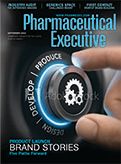
Cell and Gene Therapy Check-in 2024
January 18th 2024Fran Gregory, VP of Emerging Therapies, Cardinal Health discusses her career, how both CAR-T therapies and personalization have been gaining momentum and what kind of progress we expect to see from them, some of the biggest hurdles facing their section of the industry, the importance of patient advocacy and so much more.
